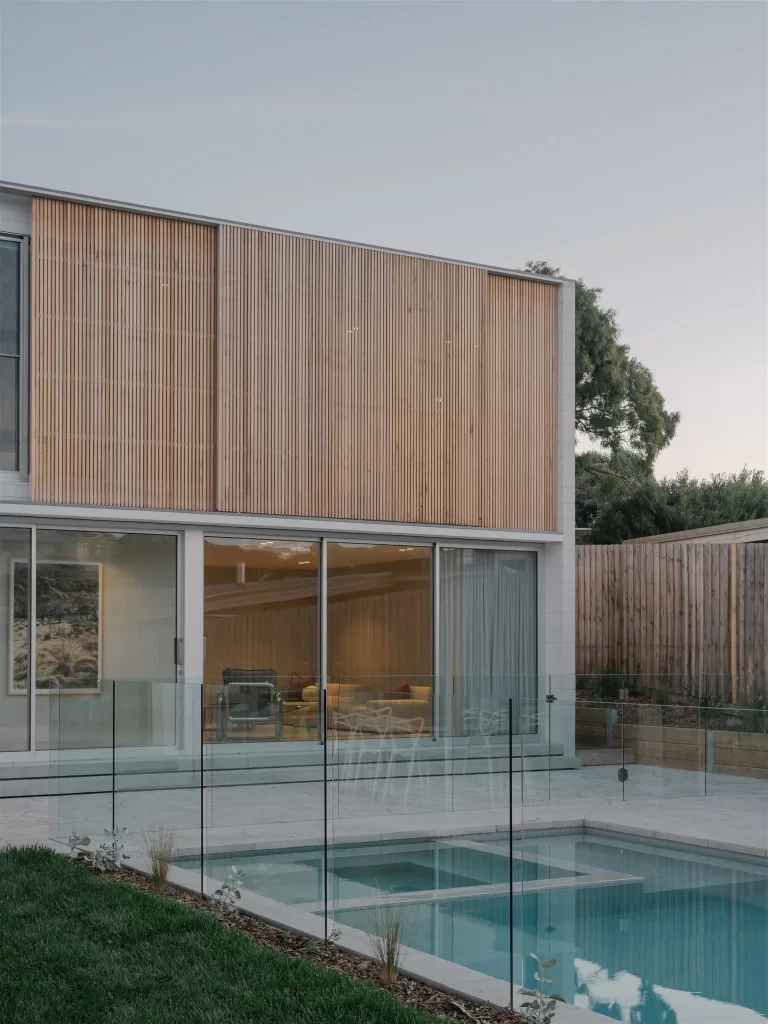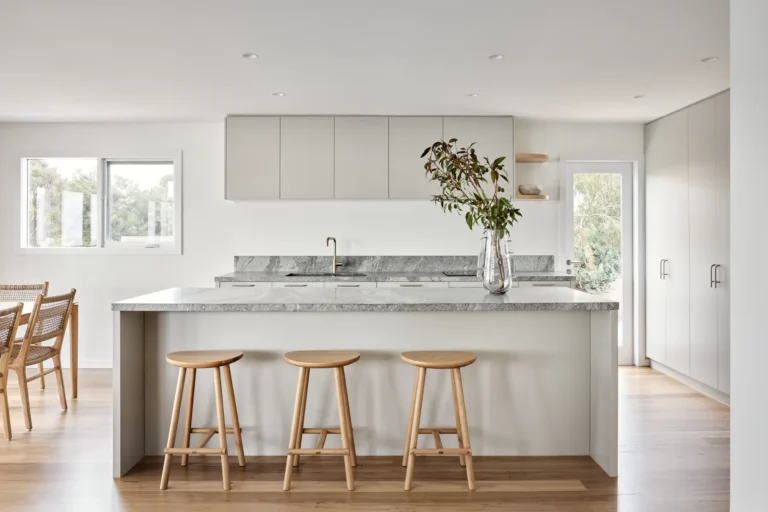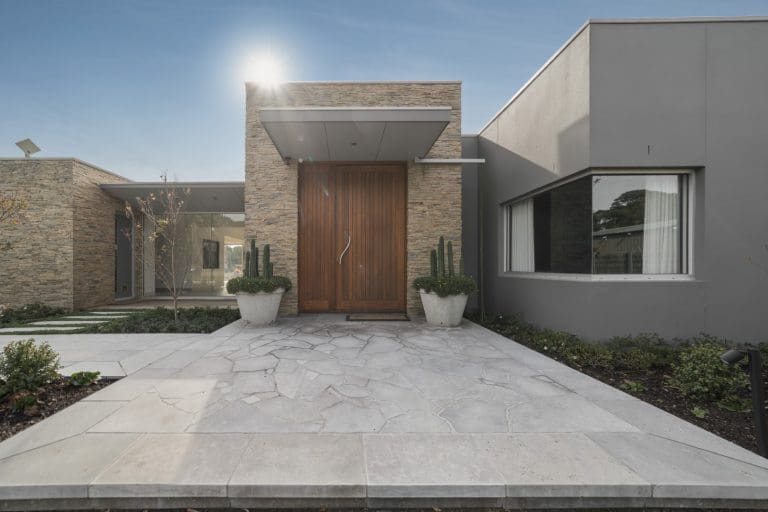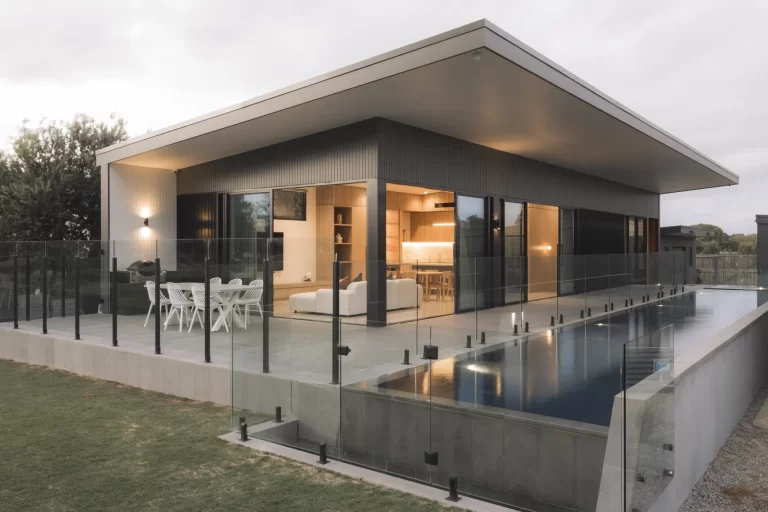For over four decades, we at RMS Traders have seen the transformative power of natural stone in creating truly bespoke outdoor spaces across Melbourne and Australia. Few paving styles capture the imagination quite like Crazy Paving.
It’s a unique, organic mosaic of irregular natural stone, often called Flagstone, that delivers a timeless elegance that transcends design trends. However, achieving that flawless, enduring finish demands far more than just laying down random stones. It requires expert knowledge, meticulous preparation, and the deliberate avoidance of common, yet costly, mistakes.
A perfectly executed Crazy Paving surface can last for generations; a poorly executed one can start cracking, shifting, and staining in under a year.
As Australia’s trusted supplier of premium natural stone, we’ve created this in-depth guide to highlight common pitfalls and offer expert solutions to ensure your Crazy Paving projects across Australia, especially in Melbourne, are a resounding success.


Fundamental Errors in Crazy Paving Planning & Material Selection
Before the first shovel hits the dirt, the fate of your project is determined by your initial choices. Choosing the right material for the job is paramount.
1- Choosing the Wrong Stone Density
Many first-time buyers are tempted by soft, delicate stones (such as some porous limestones or soft marbles) simply because of their colour, without considering their density rating (MOR, or Modulus of Rupture).
The Mistake:
Using very soft stones that are beautiful but lack the durability for constant outdoor exposure. These stones scratch easily, chip under heavy foot traffic, and absorb water like a sponge.
The RMS Expert Solution:
Match the stone’s hardness to the application:
High-Traffic Areas (Driveways, Main Paths): Choose highly dense, durable stones like Bluestone, Granite, or high-quality Quartzite. These materials are inherently resistant to impact, scratching, and heavy loads.
Low-Traffic Areas (Patios, Feature Gardens): Softer stones like Travertine or selected Limestone are acceptable, provided you acknowledge their porosity and commit to rigorous sealing. Their aesthetic reward is worth the trade-off in maintenance.
2- Selecting the Wrong Surface Finish
The unique texture of Crazy Paving is its charm, but some finishes can pose a serious safety hazard, particularly in Australia, where outdoor living is often barefoot and involves wet areas.
The Mistake:
Using highly polished or honed finishes for any outdoor surface, especially around pools, outdoor showers, or steeply sloped paths. When wet, a polished natural stone surface becomes dangerously slippery.
The RMS Expert Solution:
Prioritise high slip-resistance. Always select stone with a natural, textured finish:
Natural Split: The stone’s natural cleavage provides excellent grip.
Tumbled: The process smooths sharp edges while maintaining a rugged, non-slip surface.
Sandblasted/Flamed: These processes intentionally roughen the surface, making them the gold standard for areas like pool surrounds and steps where a high P4 or P5 slip rating is critical.

3- Underestimating Stone Thickness for Your Crazy Paving
Genuine natural stone Crazy Paving is typically sold in random thickness to enhance the organic aesthetic. Misjudging the required thickness is a shortcut that leads to premature failure.
The Mistake:
Using thin, brittle offcuts (pavers under 20mm thick) and expecting them to carry heavy, concentrated loads (such as a wheelbarrow, furniture legs, or car tyres). The thin stone will snap and crack across the joints.
The RMS Expert Solution:
Maintain the minimum required thickness for your stone type and application:
Standard Foot Traffic (Patios/Paths): We recommend stone that is 20mm or thicker. This thickness provides adequate mass and structural stability when set in mortar.
Driveways or High Load Areas: Insist on a minimum thickness of 30mm or more. This dense, robust paving will better distribute the vehicle load across the sub-base, preventing failure.
Critical Failures in Sub-Base Preparation & Laying
The ground beneath your Crazy Paving is the most important element of the entire structure. If the foundation fails, the mosaic will fail. This is where most DIY and inexperienced contractor mistakes occur.
1- Inadequate Excavation and Compaction
A firm, non-moving base is mandatory. Skipping or rushing the base preparation is a guarantee of future defects.
The Mistake:
Not digging deep enough or failing to compact the sub-base properly. The natural stone, mortar, and aggregate layers require significant depth (typically 150mm–200mm total). If the road base is loose or thin, the ground beneath will shift, causing your pavers to move, sink, and crack.
The RMS Expert Solution:
Commit to the Road Base and Compaction Standard:
- Excavate: Dig to the required depth (stone thickness + bedding depth + 100-120mm for the sub-base).
- Lay Road Base: Fill with 100-120mm of crushed rock (road base).
- Compaction: Use a vibrating plate compactor to consolidate the road base until it is rock-hard. This is the structural layer, do not cut this corner.
2- Neglecting Proper Drainage (The Pooling Hazard)
Water is the enemy of any outdoor hard surface. Allowing water to sit or pool will rapidly degrade your paving.
The Mistake:
Failing to establish a slope or fall away from any structures (like your home or alfresco area) or paving surface. Water then sits on the surface, weakening the bedding mortar and causing efflorescence and moss growth.
The RMS Expert Solution:
Install a Positive Slope:
- Ensure a gentle gradient of at least 1–2% (10mm to 20mm drop per meter) moving away from your building.
- This positive fall ensures surface water immediately drains into the garden or dedicated drainage channels, protecting both your paving and your home’s foundations.
3- Lying on the Wrong Bedding
Some softscape paving allows for stones to be laid on sand alone. This is not suitable for premium Crazy Paving.
The Mistake:
Laying heavy, irregular natural stone pieces on a sand-only base, particularly in high-traffic areas or on ground prone to movement. This causes stones to wobble, shift, and eventually become trip hazards as the sand washes out.
The RMS Expert Solution:
Use a Mortar Bed with a Bonding Slurry:
- For heavy natural stone, a wet-bed installation using a coarse sand and cement mix (approx. 4:1) is the professional standard.
- Crucially, apply a bonding slurry (cement mixed with a flexible polymer additive or water) to the back of each stone piece and to the surface of the base before laying. This creates an impermeable, lasting bond, effectively locking the stone down and preventing water ingress beneath the paver.


Execution, Design, and Grouting Blunders
Even with a perfect base, execution errors during the “jigsaw puzzle” phase and final finishing can ruin the visual appeal and long-term performance.
1- Inconsistent Joint Gaps | The Messy Mosaic
The goal of Crazy Paving is to look random, but in reality, a disciplined hand is required.
The Mistake:
Allowing wildly inconsistent gaps between the stones, some joints too tight, others far too wide (e.g., over 30mm). Joints that are too wide require excessive grout, which becomes the structural weak point of the path and looks amateurish.
The RMS Expert Solution:
Discipline the Gap:
- Aim for a target joint width of 10mm to 20mm across the entire project. This provides enough space for the grout to key in deeply while maintaining the visual continuity of the stone.
- Use a consistent object (like a piece of dowel or a stone spacer) as a guide while laying to keep your spacing uniform.
2- Laying in Straight Lines | Killing the ‘Crazy’
The irony of the style is that the natural stone itself must be placed in a way that avoids straight alignment.
The Mistake:
Unintentionally aligning paver edges or joints, leading to visual lines that cut across the surface. This happens when the installer starts placing stones in columns or rows, defeating the purpose of the organic mosaic.
The RMS Expert Solution:
Embrace the Chaos:
- When placing a new piece, actively avoid creating a continuous, uninterrupted joint that runs parallel to the previous one.
- Start the lay with the largest stones in the main body of the path, then use the medium and small pieces to fill the surrounding voids. This technique naturally breaks up the pattern and preserves the desired “crazy” aesthetic.
3- Skipping Sealing on Porous Stone
This mistake is the most damaging for the aesthetic longevity of your Crazy Paving.
The Mistake:
Failing to pre-seal and top-seal highly porous stones like Travertine, Limestone, and some Sandstones. These stones, particularly around outdoor kitchens or entertaining areas, will rapidly absorb red wine, oil, grease, and leaf tannins, leading to permanent, dark stains.
The RMS Expert Solution:
Implement the Two-Stage Sealing Protocol:
- Pre-Seal (Essential): Apply a high-quality, penetrating sealer to the face of the stone before you begin grouting. This creates a barrier that prevents grout residue (cement haze) from penetrating the stone, making cleanup drastically easier.
- Top-Seal (Mandatory): Once the grout is fully cured and the path is dry (typically 1–2 weeks), apply a final, heavy coat of penetrating sealer. This provides the long-term barrier against moisture and stains, protecting your investment for years.
4: Poor Grout Application & Cleanup (The Hazy Finish)
Grout is essential for locking the pavers together, but it can quickly ruin the stone’s natural beauty if applied incorrectly.
The Mistake:
Using the wrong type of grout (e.g., standard tile grout) or, more commonly, failing to clean the stone surface adequately while the grout is still wet. This leaves a tough-to-remove cement haze or grout film that dulls the stone’s colour and traps dirt.
The RMS Expert Solution:
Grout Cleanliness is Next to Godliness:
- Use Wide-Joint Grout: Choose a polymer-modified, wide-joint external-grade grout, or a stiff mortar mix. This material is designed for the deep, wide gaps of Crazy Paving.
- Wipe Immediately: When pushing the grout into the joints, ensure you use a rubber float to scrape off excess material. Then, use a damp (not soaking wet) tiling sponge to wipe the stone surface immediately, rinsing the sponge frequently with clean water.
- Avoid Acidic Cleaners: Never use acidic cleaners to remove haze, as they will etch and permanently damage the face of your natural stone.

FAQs:
What is the most common mistake when laying crazy paving?
The most common mistake is improper planning and layout. Many people start placing stones without considering the overall pattern, slope, or spacing, which can lead to uneven surfaces and drainage issues. Careful planning ensures a visually appealing and functional paved area.
How do I prevent uneven surfaces and gaps between crazy pavers?
To prevent uneven surfaces, use a solid base like compacted sand or gravel, and lay the stones on a consistent level. Maintain proper spacing between each paver, and fill gaps with sand, mortar, or gravel depending on the design. Regularly checking levels with a spirit level helps achieve a smooth finish.
Which type of stone and thickness is best for durable crazy paving?
Natural stones like travertine, sandstone, or slate are ideal for crazy paving. The recommended thickness is usually 30–40mm for foot traffic areas and 40–50mm for driveways. Thicker stones reduce the risk of cracking and ensure long-lasting durability.
Conclusion: Build It Right, Build It Once with RMS Traders
Crazy Paving is an enduring investment that adds unmatched character to your home. By diligently avoiding these common pitfalls in material selection, sub-base preparation, and finishing techniques, you will secure a beautiful, stable, and long-lasting installation.
At RMS Traders, our decades of experience in sourcing premium Bluestone, Travertine, Quartzite, and other natural stones means we only stock materials proven to perform in the harsh Australian environment.
Don’t let a few common mistakes compromise your vision. Trust the expertise of RMS Traders for the highest quality Crazy Paving Melbourne has to offer. Visit one of our showrooms or explore our collection online to start your project with confidence.




